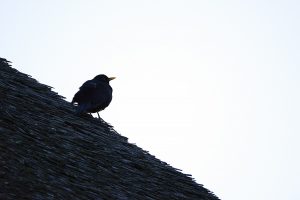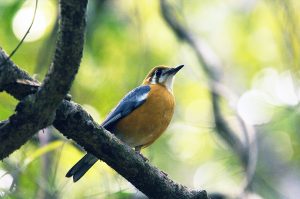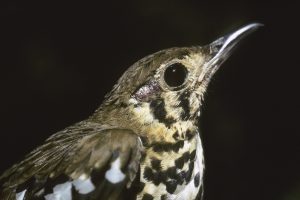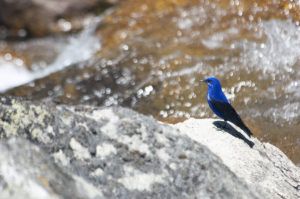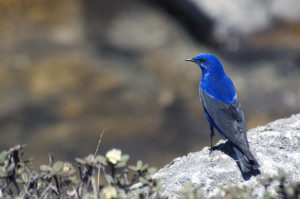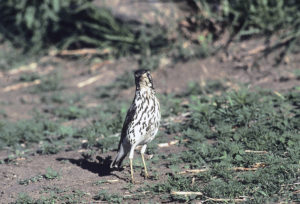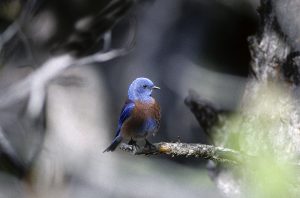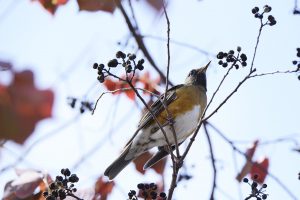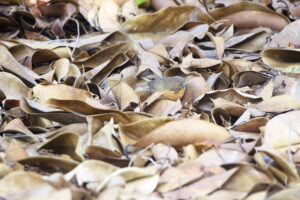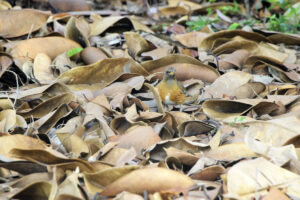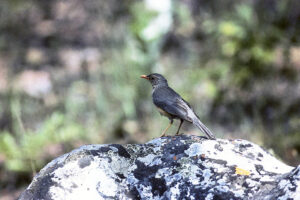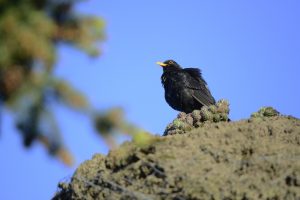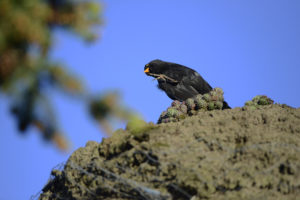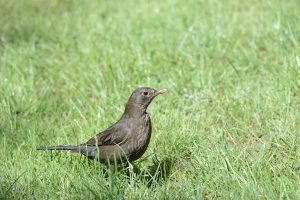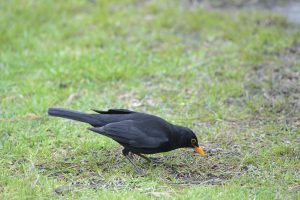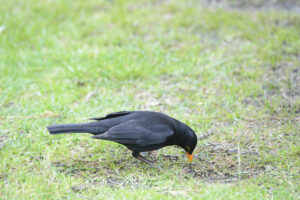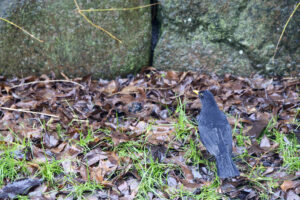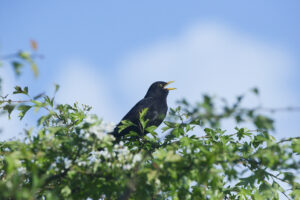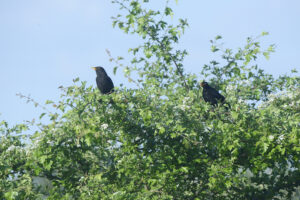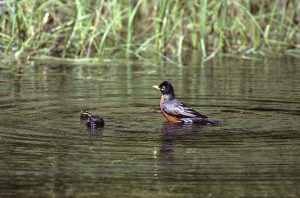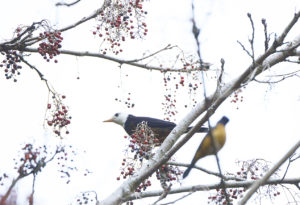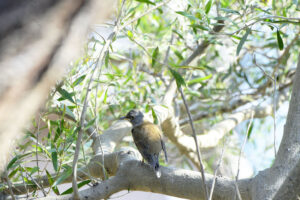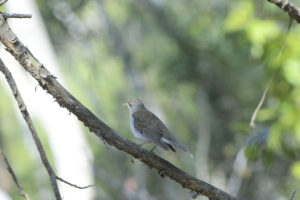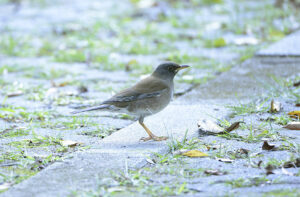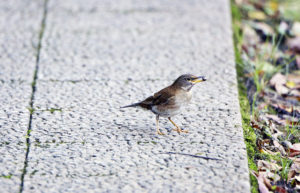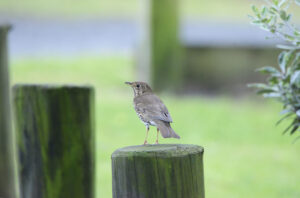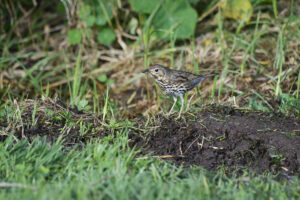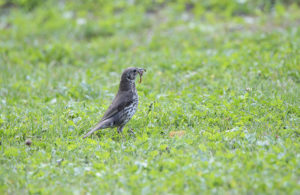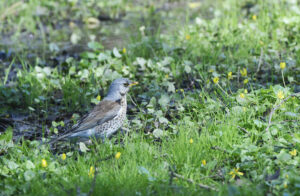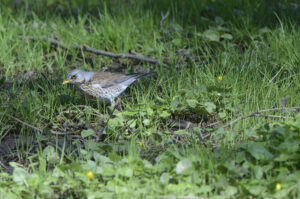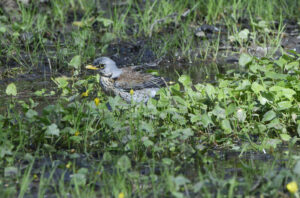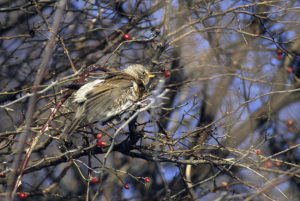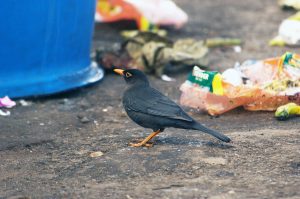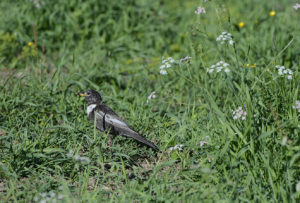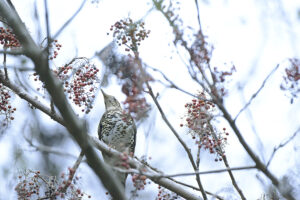Thrushes
Before dawn, my childhood neighborhood would echo with the melodious song from a chorus of blackbird males. (Photo copyright © by Kaj Halberg)
Blackbird singing in the dead of night,
Take these broken wings and learn to fly.
All your life
You were only waiting for this moment to arise.
Blackbird singing in the dead of night,
Take these sunken eyes and learn to see.
All your life
You were only waiting for this moment to be free.
Blackbird fly, blackbird fly
Into the light of a dark black night.
Written by English musician and songwriter Paul McCartney (born 1942), from the double album The Beatles, 1968. Although the song of a blackbird is heard in the performance, the song was in reality caused by racial tension in the southern United States, and should be seen as an encouragement to the black people in their struggle for equality.
“There, on the grey stone in the grass, was an enormous thrush, nearly coal black, its pale yellow breast freckled with dark spots. Crack! It had caught a snail and was knocking it on the stone. Crack! Crack!”
From the novel The Hobbit (1937), by English linguist and author J.R.R. Tolkien (1892-1973).
From childhood, I have been fond of thrushes. I was deeply fascinated by the blackbird, which, cocking its head, was listening for movements beneath our lawn, and would then suddenly sink its bill into the ground and pull forth a wriggling earthworm. And in the summertime, before dawn, our neighborhood would echo with the melodious song from a chorus of males, performed from tree tops, flagpoles, or rooftops.
On family picnic trips to the woods, we could enjoy the more staccato-like song of the blackbird’s smaller cousin, the song thrush, which constantly changed its theme and would variate the song indefinitely.
Later, when I had developed a deeper interest in birds, I realized that other species of thrushes could be encountered in Denmark. In the coniferous plantations of Jutland, you might get a glimpse of the mistle thrush, which resembled a large song thrush, but could be identified by its white underwing and the hissing call, reminiscent of a wren’s call.
In spring, you might be lucky enough to observe a small flock of ring ouzels, feeding in a field before continuing their northbound migration. And one of the positive signs of autumn were large flocks of fieldfares and redwings, zooming across windblown fields, or tucking into the abundant supplies of rosehips, haws, elder berries, or fallen apples.
When I began travelling, I encountered many other species of thrushes. The family Turdidae is still large, although numerous smaller species, following a number of genetic studies, have now been transferred to other families. The genus Turdus, to which our European thrushes belong, is by far the largest genus, comprising about 84 species, and otherwise the family presently encompasses 17 other genera, counting altogether about 80 species.
The word thrush is derived from Old English throstle, from Proto-Germanic þrustlō, an ancient name for the song thrush. In Old Saxon, þrustlō became throsla, in German Drossel. The latter name was adopted by the Danes, whereas the Swedes use the name trast for these birds, and the Norwegians trost.
Below, a number of species of the thrush family, which I have managed to photograph around the world, are presented.
Information on the etymology behind the scientific names is based on J.A. Jobling 2010. The Helm Dictionary of Scientific Bird Names, Christopher Helm.
Geokichla
In 2008, 22 species, which had been previously placed in the genus Zoothera (below), were transferred to the genus Geokichla, established in 1836 by German naturalist Salomon Müller (1804-1864), who explored parts of Dutch East Indies (today Indonesia) between 1826 and 1835.
The generic name is derived from Ancient Greek geo (‘ground’) and kikhle (‘thrush’), referring to the almost exclusively ground-feeding habit of these birds.
Geokichla citrina Orange-headed ground-thrush
This pretty bird, divided into 11 subspecies, breeds along the entire Himalayan Range, in eastern and Southern India, on the Andaman and Nicobar Islands, in Indochina, southern and eastern China, and northern Borneo, and on Java and Bali. It is resident in the major part of this huge area, but some northern populations are migratory, spending the winter in north-eastern and southern India, Sri Lanka, Sumatra, and southern China.
Subspecies cyanota of southern India is very distinct, having a white face with two vertical black streaks below and behind the eye. It has been suggested that it forms a separate species, but intermediate forms occur where its range overlaps with that of nominate citrina.
This picture shows the distinct subspecies cyanota of orange-headed ground-thrush, encountered in Mahaveer Wildlife Sanctuary, Goa, India. (Photo copyright © by Kaj Halberg)
This orange-headed ground-thrush (subspecies rubecula) is for sale at a bird market in the town of Kintamani, Bali, Indonesia. Legal and illegal bird trade takes place on a huge scale in many parts of Asia. (Photo copyright © by Kaj Halberg)
Geokichla guttata Spotted ground-thrush
This species, previously named Zoothera guttata, is a scarce bird with a very fragmented distribution, found in a few forest areas in South Sudan, Zaire, Kenya, Tanzania, Malawi, South Africa, and possibly Mozambique. It is severely threatened by loss of suitable habitat.
It spends much time searching for small invertebrates among the leaf-litter on the forest floor. Its distinctive colouration is an adaptation that makes it difficult to see among the leaves.
The specific name is Latin, meaning ‘spotted’ or ‘speckled’.
This spotted ground-thrush has been caught in a mist-net to be ringed, Rondo Forest, southern Tanzania. (Photo copyright © by Kaj Halberg)
Grandala coelicolor Grandala
The only species in the genus, described in Nepal in 1843 by British naturalist and ethnologist Brian Houghton Hodgson (1801-1894), who found numerous species of birds and mammals, new to science, in the Himalaya.
The male is a gorgeous bird, whose plumage is an almost iridescent hue of blue, whereas the female is greyish with faint white stripes on head, nape, and breast, and a brownish tinge to the wings.
It is distributed from Kashmir along the entire Himalayan chain, and thence northwards through eastern Tibet to western China, from northern Yunnan northwards to eastern Qinghai. It breeds at very high altitudes, between 4,000 and 5,500 m, moving to slightly lower elevations in winter.
Classification-wise, this species has been knocked about a great deal. Initially, it was regarded as belonging to the thrush family, but following some genetic studies it was then transferred to the flycatcher family (Muscicapidae). However, recently it has been moved back to the thrush family!
The generic and specific names are derived from the Latin grandis (‘grand’) and ala (‘wing’), and coelum or caelum (‘sky’) and color (‘colour’), both names of course alluding to the splendid plumage of the male.
From a stone in a mountain stream in the Gokyo Valley, Khumbu, eastern Nepal, this male grandala would take off and flutter about butterfly-like to snap an insect, before returning to its vantage point. (Photos copyright © by Kaj Halberg)
Neocossyphus Ant-thrushes
Ant-thrushes are two species of medium-sized insectivorous birds, living in forests of sub-Saharan Africa.
The generic name is derived from Ancient Greek neos (‘new’) and kossyphos, the name of the blackbird (Turdus merula).
Neocossyphus rufus Red-tailed ant-thrush
This species is found in two geographically separate areas, from southern Cameroun and Gabon eastwards across northern Zaire to western Uganda, and in coastal forests of Kenya and Tanzania, including Zanzibar.
The specific name refers to the rufous underside of this bird.
This red-tailed ant-thrush has been caught in a mist-net to be ringed, Rondo Forest, southern Tanzania. (Photo copyright © by Kaj Halberg)
Psophocichla
This is a small genus of one or two species, depending on authority. Here, I follow Handbook of the Birds of the World (Lynx Edicions), which proposes two species.
The generic name is derived from Ancient Greek psóphos (‘loud noise’) and kikhle (‘thrush’), referring to the loud, clicking call of these birds.
Psophocichla litsitsirupa Groundscraper thrush
A most striking bird, easily identified by its upright stance, streaked breast, and two black vertical stripes below and behind the eye, similar to those of subspecies cyanota of the orange-headed ground-thrush (see Geocichla above).
This species occurs in grasslands and open woodland, from northern Angola eastwards to western Tanzania, Malawi, and north-western Mozambique, southwards to Namibia and north-eastern South Africa.
The specific name litsitsirupa is a Tswana word, imitating the bird’s call.
Groundscraper thrush, Daan Viljoen National Park, Namibia. (Photo copyright © by Kaj Halberg)
Psophocichla simensis Ethiopian thrush
This bird, which is restricted to the highlands of Ethiopia and Eritrea, was formerly regarded as being conspecific with the groundscraper thrush. However, besides being geographically isolated, its black facial markings are much weaker, the spots on the underparts are fewer and rounder in shape, and the back is more brownish.
The specific name refers to the Simien Mountains of Ethiopia.
Ethiopian thrush, Dinsho, Bale Mountains, Ethiopia. (Photo copyright © by Kaj Halberg)
Sialia Bluebirds
Bluebirds comprise one of the few genera of the thrush family, which is endemic to the Americas, containing three species, which are distributed from southern Canada southwards to Nicaragua. As their name implies, they have blue plumage, two of the species also with red parts on the underside.
The generic name is derived from the original name of the eastern bluebird (Sialia sialis), in 1758 named Motacilla sialis by Carl Linnaeus. In Ancient Greek, sialis was the name of an unidentified bird, so-called from its cry, mentioned by Greek grammarians Athenaeus of Naucratis (170-223 A.D.) and Hesychius of Alexandria (5th or 6th Century A.D.).
Sialia mexicana Western bluebird
Initially, this bird was confined to open hardwood forests in grasslands, but a lot of its habitat has been destroyed by cultivation and logging. However, it has been able to adapt to other habitats, including coniferous forest, farmland, and desert, and is still quite common.
It is distributed in two geographically separate areas, from British Columbia, Washington, and Montana southwards through Oregon, California, and western Nevada to northern Baja California, and from Utah and Colorado southwards to the Mexican states of Oaxaca and Veracruz. Northern populations are migratory, spending the winter in south-western United States and northern Mexico.
Male western bluebird, Grand Canyon National Park, Arizona. (Photo copyright © by Kaj Halberg)
Turdus Typical thrushes
Comprising about 84 species, this genus is distributed in the major part of the globe. The generic name is the classical Latin word for thrush.
Turdus chrysolaus Brown-headed thrush
This bird is endemic to East Asia, breeding from Sakhalin and the Kuril Islands southwards to central Honshu, Japan, spending the winter in southern Japan, Taiwan, and the Philippines. It is mainly of a warm brown colour, with reddish breast and white central belly. The male has blackish-brown head and throat, whereas the female has whitish throat with black vertical stripes.
The specific name is derived from Ancient Greek khrysos (‘gold’) and laios (‘thrush’).
The brown-headed thrush is a common migrant and winter visitor in Taiwan. This male is feeding on fruits of a Chinese tallow-tree (Triadica sebifera) in a city park in Taichung. A collection of pictures, depicting the gorgeous winter foliage of this tree, is shown on the page Autumn. (Photo copyright © by Kaj Halberg)
Female brown-headed thrush, eating fruits of maritime persimmon (Diospyros maritima), Taitung, Taiwan. (Photos copyright © by Kaj Halberg)
This female is very well camouflaged, feeding among dead leaves, Tunghai University Park, Taichung. (Photos copyright © by Kaj Halberg)
Turdus iliacus Redwing
The name of this small thrush stems from its red underwing and flanks. It breeds in northern Europe and Asia in open forests and montane shrubs of birch and willow, from Iceland and northern Scotland eastwards through the entire Scandinavian Peninsula, Finland, and Russia to eastern Siberia. It is also found in the Baltic States, eastern Poland, Belarus, and northern Ukraine, and in Central Asia, it breeds as far south as northern Kazakhstan and northern Mongolia. It breeds sporadically in Denmark, and since 1990, a small population has also been breeding in southern Greenland.
This species is migratory, spending the winter in western Europe, and around the Mediterranean, the Black Sea, and the Caspian Sea. Some birds in south-western Norway and Scotland are resident.
The specific name is Latin, meaning ‘of the flanks’, derived from ile (‘flanks’), naturally alluding to the red flanks.
Flock of redwing in autumn, Funen, Denmark. (Photo copyright © by Kaj Halberg)
Feeding redwing, Skaftafell, southern Iceland. (Photo copyright © by Kaj Halberg)
Redwing nest with young, built under the hood of a tractor, Aðaldal, Iceland. (Photo copyright © by Kaj Halberg)
Turdus libonyana Kurrichane thrush
This species is found from Angola, north-eastern Namibia, and south-eastern Zaire to the east coast of Africa, and from south-eastern Burundi and northern Tanzania southwards to south-eastern South Africa, living in dry savanna and open woodland. It resembles the African thrush (below), but has a whitish throat with a black malar stripe on each side.
The specific name was given by mistake to this species. It is derived from lebonyana, the Tswana name for the red-billed buffalo-weaver (Bubalornis niger). The prefix Kurrichane is a corruption of the name Kaditshwene, a place in South Africa, where the original specimen was collected. That name is thought to be derived from a Tswana expression: “Ga se ka ditshwene!”, meaning “What an incredible number of baboons!” (Boeyens 2000).
Kurrichane thrush, Chimanimani National Park, eastern Zimbabwe. (Photo copyright © by Kaj Halberg)
Turdus merula Blackbird
The black plumage of the male blackbird has given rise to its name. The Proto-Germanic name for this bird was amslo, which in German became Amsel, and in Old English osle, which was later changed to wosel, wozel, or ouzel, the latter used until about the 17th Century. Incidentally, ouzel is still used in the name ring ouzel (below).
In A Midsummer Night’s Dream, by William Shakespeare (1564-1616), the weaver Nick Bottom sings:
The woosell cocke, so blacke of hew,
With orenge-tawny bill,
The throstle, with his note so true,
The wren and little quill.
During the last hundred years or so, the blackbird has spread to virtually all urban areas in Europe, and today it is one of the most common city birds. From being a shy forest bird, it has changed to become very confiding indeed, sometimes breeding in garages and tool sheds, where the incubating female will not leave the nest, even if the owner is doing his business close to it.
Blackbirds are very territorial, even in winter. In my childhood garden, we were feeding birds in the winter, among other things with half-rotten apples, which were much appreciated by the blackbirds. There would always be a male, which claimed exclusive rights to the apples, and he spent a great deal of time chasing the other birds away. However, when he was occupied chasing one bird, the others would see their chance to eat from the apples, so, presumably, they got a larger share than the aggressive male.
This species is distributed from Iceland and northern Scandinavia southwards to Morocco, Egypt, and Jordan, and thence eastwards across northern Iraq and Iran to eastern Kazakhstan and Kyrgyzstan. In Russia, it is restricted to the westernmost part. Central Asian birds, which were formerly considered to be a subspecies of the blackbird, are now generally regarded as a subspecies of Turdus maxima.
The blackbird was introduced to Australia in 1857 and to New Zealand in 1862. Today, it is one of the commonest birds in New Zealand.
The specific name is the classical Latin name of the blackbird.
Male blackbird, preening on a rooftop, Funen, Denmark. (Photos copyright © by Kaj Halberg)
The plumage of the female blackbird is a mottled dark brown, and its bill is yellow with a brownish base. – Hamburg, Germany. (Photo copyright © by Kaj Halberg)
Today, the blackbird is one of the commonest birds in New Zealand. This male is listening for earthworms on a lawn near Muriwai Beach. (Photos copyright © by Kaj Halberg)
Male blackbird, feeding by tossing over fallen leaves, Funen, Denmark. (Photo copyright © by Kaj Halberg)
This singing blackbird was sitting in a bush, north of Aarhus, Jutland, Denmark, when another male landed in the same bush. For a short while, they were both singing, but then started fighting vigorously. (Photos copyright © by Kaj Halberg)
Turdus migratorius American robin
As a breeding bird, this species has a very wide distribution indeed, from northern Alaska and Canada southwards through the entire United States (except Florida), to north-western Mexico and Baja California. Northern populations are migratory, wintering from the southernmost parts of Alaska and Canada southwards to southern Mexico and Guatemala. It is one of the commonest land birds of North America, and is the state bird of Connecticut, Michigan, and Wisconsin.
The American robin is regarded as a symbol of spring. The poem The First Robin, by Canadian poet William Henry Drummond (1854-1907), is based on a Quebec superstition that whoever sees the first robin of spring will have good luck.
This bird was named robin by early settlers, as its reddish-orange breast reminded them of the European robin (Erithacus rubecula).
Male American robin in morning light, Shenandoah National Park, Appalachians. (Photo copyright © by Kaj Halberg)
This male is collecting food for its young, Mount Rainier, Washington, United States. (Photo copyright © by Kaj Halberg)
Male American robin, bathing in a pond near Lake Schoen, Vancouver Island, Canada. (Photo copyright © by Kaj Halberg)
Turdus niveiceps Taiwan thrush
Previously, this bird was treated as a subspecies of the widespread island thrush (T. poliocephalus), but is now generally regarded as a separate species, which is restricted to Taiwan. It mainly lives in montane forests at moderate altitudes, but is occasionally seen in the lowlands.
The adult male is a very pretty bird, with black back and breast band, reddish belly, and pure white head, whereas the female has brown back and crown, buffy eye stripe, reddish breast and belly, and whitish throat.
The specific name is derived from the Latin niveus (‘snow-white’) and ceps (‘headed’), ultimately from caput (‘head’).
Male Taiwan thrush, feeding on berries of Chinese wonder tree (Idesia polycarpa), Dasyueshan National Forest. A male small vivid niltava (Niltava vivida) is seen in the background. (Photo copyright © by Kaj Halberg)
Young male Taiwan thrush, feeding among dead leaves, Longluan Lake, Kenting National Park. (Photo copyright © by Kaj Halberg)
Turdus pallidus Pale thrush
As its name implies, this species has a rather drab plumage, brown on the wings and back, white underside speckled with reddish-brown, and greyish head with a narrow yellow eye-ring. It lives in forests, breeding in south-eastern Siberia (Ussuriland), north-eastern China, and Korea, and wintering in Korea, southern Japan, south-eastern China, and Taiwan.
Pale thrush, Taichung, Taiwan. (Photos copyright © by Kaj Halberg)
Pale thrush, Taroko Gorge, Taiwan. (Photos copyright © by Kaj Halberg)
Turdus pelios African thrush
This bird, divided into about 9 subspecies, is distributed south of the Sahara, from Senegal eastwards to South Sudan and Ethiopia, southwards to northern Angola and northern Zambia.
Previously, 7 of these subspecies were included in the olive thrush (T. olivaceus), which was described in 1760 by French naturalist Mathurin Jacques Brisson (1723-1806) in his Ornithologie, ou, Méthode contenant la division des oiseaux en ordres, sections, genres, especes & leurs variétés, based on a specimen collected from Cape of Good Hope, South Africa. He applied a French name to it, Le merle olive du Cap de Bonne Espérance, and also a Latin name, Merula Olivacea Capitis Bonae Spei, both names meaning ‘the olive thrush of Cape of Good Hope’.
In 1766, when the well-known Swedish naturalist Carl Linnaeus (1707-1778) updated his Systema Naturæ for the 12th edition, he added 240 species, which Brisson had previously described, including the olive thrush, naming it Turdus olivaceus, and citing Brisson’s work (Allen 1910).
There is still some controversy about the relationship between these two species, and some authorities maintain that some of the subspecies of African thrush should be transferred back to the olive thrush, which, as of today, is restricted to southern Africa.
In Ancient Greek, pelios has several meanings: ‘bruised’, ‘black and blue’, and ‘livid’. What it refers to in this case is not clear.
African thrush (subspecies centralis) in morning light, Aberdare National Park, Kenya. (Photo copyright © by Kaj Halberg)
Turdus philomelos Song thrush
As explained at the top of this page, the ancient Proto-Germanic name of the song thrush, þrustlō, has given name to the entire group. The specific name is derived from Ancient Greek philein (‘to love’) and melos (‘melody’), alluding to the fantastic song of this bird.
The song thrush has a wide distribution, breeding from northern Norway southwards to northern Spain, Italy, northern Greece, northern Turkey, and northern Iran, and from Ireland eastwards through Europe and Siberia, almost to Lake Baikal. Northern and eastern populations are migratory, spending the winter in southern Europe, northern and north-eastern Africa, and the Middle East. It was introduced to New Zealand in 1862, and today it is very common here. It is also found in a relatively small area of south-eastern Australia.
The song thrush is an expert singer. This one was photographed near the Waitomo Caves, New Zealand. (Photo copyright © by Kaj Halberg)
Song thrush, Muriwai Beach, New Zealand. (Photo copyright © by Kaj Halberg)
This song thrush has been searching for food in the ground. A bit of soil still sticks to its bill. – New Plymouth, New Zealand. (Photo copyright © by Kaj Halberg)
This song thrush has caught earthworms to feed its young, Baca Valley, northern Slovenia. (Photo copyright © by Kaj Halberg)
Turdus pilaris Fieldfare
The fieldfare is a large thrush, which breeds in scrubland and open forests, from northern Norway southwards to France, Switzerland, northern Italy, northern Slovenia, and northern Ukraine, and from eastern France eastwards across the entire taiga zone to eastern Siberia, Mongolia, and northern China. In England, it is a scarce breeding bird. Populations of Scandinavia and Siberia are migratory, spending the winter in the British Isles, southern Europe, northern Africa, the Middle East, and areas around the Caspian Sea.
The name fieldfare is derived from the 11th Century word feldefare, which, according to some authorities, means ‘traveller across the fields’. However, in a paper from 1855, On False Etymologies, in Transactions of the Philological Society (6): 69, H. Wedgwood points out that this is a false presumption. In reality, the name is derived from the old Anglo-Saxon name of the bird, feala-for, perhaps alluding to the tawny-yellow colour on the breast.
In Latin, pilaris means ‘thrush’, but this name is in reality based on a misunderstanding. The Ancients mistook the Greek word trikhas, which denoted a kind of thrush, for trikhos (‘hair’), so in Latin it became pilaris (‘to deprive of hair’), derived from pilus (‘hair’).
Feeding fieldfare, near Lake Furesøen, northern Zealand, Denmark. (Photos copyright © by Kaj Halberg)
Bathing fieldfare, Furesøen. (Photo copyright © by Kaj Halberg)
In winter, fieldfares often feed on various berries and fruits. This bird in eastern Jutland, Denmark, is eating hips of dog rose (Rosa canina). (Photo copyright © by Kaj Halberg)
Nest of fieldfare in a dwarf birch (Betula nana), which is scrambling over a rock, Marsfjällen, Lapland, Sweden. (Photo copyright © by Kaj Halberg)
Turdus simillimus Indian blackbird
Four subspecies of this bird are distributed in montane areas of the southern half of the Indian Peninsula and in Sri Lanka. Formerly, they were regarded as subspecies of the common blackbird (above), but they are rather smaller, only c. 20 cm versus c. 25 cm, the naked skin around the eye is broader, and egg colour and voice also differ from the common blackbird. It has been concluded that the similarity between these two species is an example of convergent evolution.
The specific name is Latin, meaning ‘very similar’ (i.e. to the true blackbird).
This male Nilgiri blackbird (subspecies simillimus) is feeding among garbage, left by tourists on the hill Dodabetta, Nilgiri Mountains, Tamil Nadu. (Photo copyright © by Kaj Halberg)
Turdus torquatus Ring ouzel
The ring ouzel is similar to the blackbird, but is slightly smaller and slimmer, and it may at once be identified by its striking white breast band, which is the cause of the first part of its name. (The name ouzel is explained under blackbird.) It also has a pale wing panel. Male and female are quite similar, but the female is greyer and has scaly markings on the underside.
Three subspecies of this bird are distributed across Europe and western Asia, breeding in all of Norway, the extreme western part of Sweden, the northern tip of Finland, on the Kola Peninsula, and in the Timan Mountains, near Arkhangelsk, and also in Scotland, northern England, Wales, and Ireland, in the Pyrenees, the Alps, and mountains of eastern Europe and the Balkans, in southern and eastern Turkey, in the Caucasus, and in northern Iran. In the major part of its distribution area, it is restricted to mountains, where it nests in gullies, rocky areas, or among scree. However, in Scandinavia and the British Isles it may be found down to sea level.
The species is migratory, spending the winter in southern Spain, North Africa, the Balkans, southern Turkey, and western Iran.
The specific name is Latin, meaning ‘necklaced’ or ‘collared’.
Female ring ouzel (subspecies alpestris), feeding in an alpine meadow, Dolomites, northern Italy. (Photo copyright © by Kaj Halberg)
Zoothera Asian thrushes
Formerly, about 46 thrush species were placed in this genus. However, at an early stage, two American species were transferred to other genera, the Aztec thrush to the genus Ridgwayia, and the varied thrush to Ixoreus. In 2008, following a number of genetic studies, about 22 other species were transferred to the genus Geokichla (above).
The generic name is derived from Ancient Greek zoon (‘animal’) and theras (‘hunter’), referring to the habit of these thrushes to be searching for invertebrates on the forest floor.
Zoothera aurea White’s thrush
Formerly, the distribution area of the scaly thrush (Zoothera dauma) was thought to be the major part of Siberia, and South and East Asia, southwards to Australia. Lately, however, this bird has been split into about 8 species, and, according to Handbook of the Birds of the World (Lynx Edicions), Siberian and East Asian birds are now called White’s thrush.
The specific name is derived from the Latin aureus (‘golden’). Presumably, it refers to the wings and back of this bird, although they are more brownish than golden. The common name commemorates English naturalist Gilbert White (1720-1793), who is best known for his book Natural History and Antiquities of Selborne, first published in 1789.
White’s thrush is a fairly common winter visitor in montane forests of Taiwan. This bird is feeding on berries of Chinese wonder tree (Idesia polycarpa), Dasyueshan National Forest. (Photo copyright © by Kaj Halberg)
References
Allen, J.A. 1910. Collation of Brisson’s genera of birds with those of Linnaeus. Bulletin of the American Museum of Natural History, 28: 317-335.
Boeyens, J. 2000. In Search of Kaditshwene. The South African Archaeological Bulletin, 55 (171): 3-17.
kcrw.com/music/shows/chris-douridas/paul-mccartney
(Uploaded October 2019)
(Latest update November 2024)
